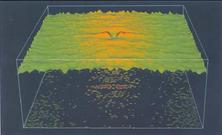Application of Statistical Physics to Understanding and Preventing Diseases Related to Protein Misfolding, such as Alzheimer Disease

For more than a decade, we have been using our expertise in statistical and condensed matter physics to study the early stages of aggregation of the amyloid beta-protein that eventually makes up the toxic fibrils and plaques found in the brains of Alzheimer patients. We are refining protein-folding models designed to identify the areas of the amyloid protein that are involved in the misfolding process, and to predict forms that the proteins are likely to take in the human brain. The protein structures that the our computer models predict are compared to actual proteins synthesized in the lab by neurological biochemist Dr. David Teplow at UCLA; this dialogue between computational models and observed results ensures that the computer models are accurately mimicking amyloid protein misfolding as it occurs in the brain of an Alzheimer patient.
 Physics (Internal)
Physics (Internal)